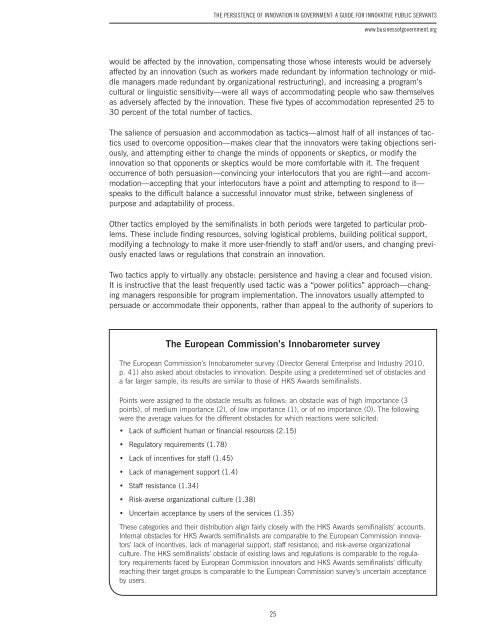The Persistence of Innovation in Government
The Persistence of Innovation in Government
The Persistence of Innovation in Government
- No tags were found...
Create successful ePaper yourself
Turn your PDF publications into a flip-book with our unique Google optimized e-Paper software.
<strong>The</strong> <strong>Persistence</strong> <strong>of</strong> <strong>Innovation</strong> <strong>in</strong> <strong>Government</strong>: A Guide for Innovative Public Servantswww.bus<strong>in</strong>ess<strong>of</strong>government.orgwould be affected by the <strong>in</strong>novation, compensat<strong>in</strong>g those whose <strong>in</strong>terests would be adverselyaffected by an <strong>in</strong>novation (such as workers made redundant by <strong>in</strong>formation technology or middlemanagers made redundant by organizational restructur<strong>in</strong>g), and <strong>in</strong>creas<strong>in</strong>g a program’scultural or l<strong>in</strong>guistic sensitivity—were all ways <strong>of</strong> accommodat<strong>in</strong>g people who saw themselvesas adversely affected by the <strong>in</strong>novation. <strong>The</strong>se five types <strong>of</strong> accommodation represented 25 to30 percent <strong>of</strong> the total number <strong>of</strong> tactics.<strong>The</strong> salience <strong>of</strong> persuasion and accommodation as tactics—almost half <strong>of</strong> all <strong>in</strong>stances <strong>of</strong> tacticsused to overcome opposition—makes clear that the <strong>in</strong>novators were tak<strong>in</strong>g objections seriously,and attempt<strong>in</strong>g either to change the m<strong>in</strong>ds <strong>of</strong> opponents or skeptics, or modify the<strong>in</strong>novation so that opponents or skeptics would be more comfortable with it. <strong>The</strong> frequentoccurrence <strong>of</strong> both persuasion—conv<strong>in</strong>c<strong>in</strong>g your <strong>in</strong>terlocutors that you are right—and accommodation—accept<strong>in</strong>gthat your <strong>in</strong>terlocutors have a po<strong>in</strong>t and attempt<strong>in</strong>g to respond to it—speaks to the difficult balance a successful <strong>in</strong>novator must strike, between s<strong>in</strong>gleness <strong>of</strong>purpose and adaptability <strong>of</strong> process.Other tactics employed by the semif<strong>in</strong>alists <strong>in</strong> both periods were targeted to particular problems.<strong>The</strong>se <strong>in</strong>clude f<strong>in</strong>d<strong>in</strong>g resources, solv<strong>in</strong>g logistical problems, build<strong>in</strong>g political support,modify<strong>in</strong>g a technology to make it more user-friendly to staff and/or users, and chang<strong>in</strong>g previouslyenacted laws or regulations that constra<strong>in</strong> an <strong>in</strong>novation.Two tactics apply to virtually any obstacle: persistence and hav<strong>in</strong>g a clear and focused vision.It is <strong>in</strong>structive that the least frequently used tactic was a “power politics” approach—chang<strong>in</strong>gmanagers responsible for program implementation. <strong>The</strong> <strong>in</strong>novators usually attempted topersuade or accommodate their opponents, rather than appeal to the authority <strong>of</strong> superiors to<strong>The</strong> European Commission’s Innobarometer survey<strong>The</strong> European Commission’s Innobarometer survey (Director General Enterprise and Industry 2010,p. 41) also asked about obstacles to <strong>in</strong>novation. Despite us<strong>in</strong>g a predeterm<strong>in</strong>ed set <strong>of</strong> obstacles anda far larger sample, its results are similar to those <strong>of</strong> HKS Awards semif<strong>in</strong>alists.Po<strong>in</strong>ts were assigned to the obstacle results as follows: an obstacle was <strong>of</strong> high importance (3po<strong>in</strong>ts), <strong>of</strong> medium importance (2), <strong>of</strong> low importance (1), or <strong>of</strong> no importance (0). <strong>The</strong> follow<strong>in</strong>gwere the average values for the different obstacles for which reactions were solicited:• Lack <strong>of</strong> sufficient human or f<strong>in</strong>ancial resources (2.15)• Regulatory requirements (1.78)• Lack <strong>of</strong> <strong>in</strong>centives for staff (1.45)• Lack <strong>of</strong> management support (1.4)• Staff resistance (1.34)• Risk-averse organizational culture (1.38)• Uncerta<strong>in</strong> acceptance by users <strong>of</strong> the services (1.35)<strong>The</strong>se categories and their distribution align fairly closely with the HKS Awards semif<strong>in</strong>alists’ accounts.Internal obstacles for HKS Awards semif<strong>in</strong>alists are comparable to the European Commission <strong>in</strong>novators’lack <strong>of</strong> <strong>in</strong>centives, lack <strong>of</strong> managerial support, staff resistance, and risk-averse organizationalculture. <strong>The</strong> HKS semif<strong>in</strong>alists’ obstacle <strong>of</strong> exist<strong>in</strong>g laws and regulations is comparable to the regulatoryrequirements faced by European Commission <strong>in</strong>novators and HKS Awards semif<strong>in</strong>alists’ difficultyreach<strong>in</strong>g their target groups is comparable to the European Commission survey’s uncerta<strong>in</strong> acceptanceby users.25


